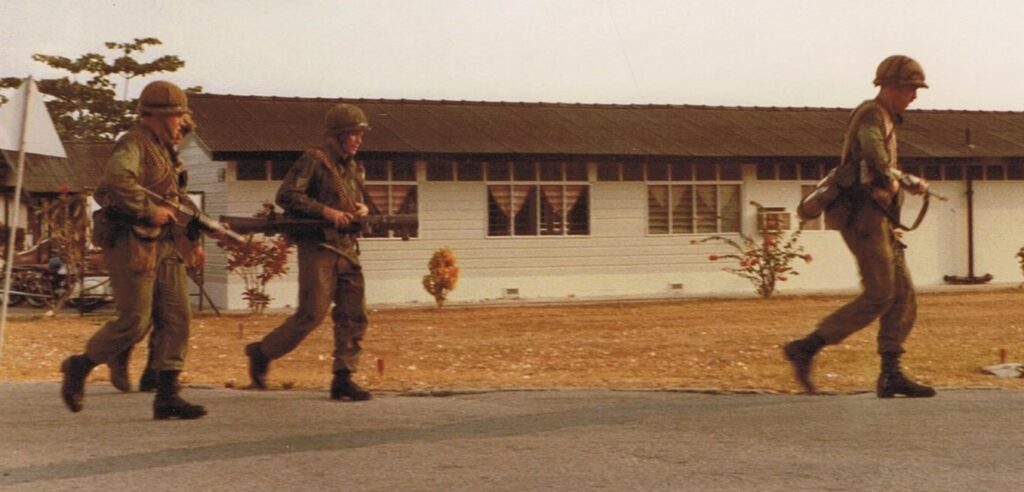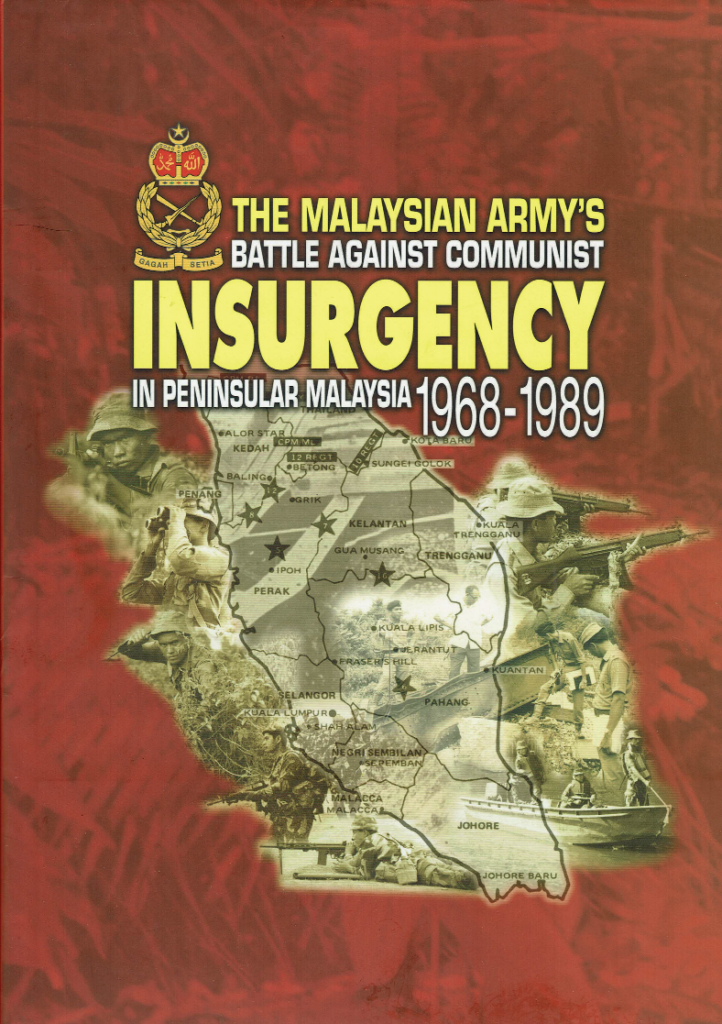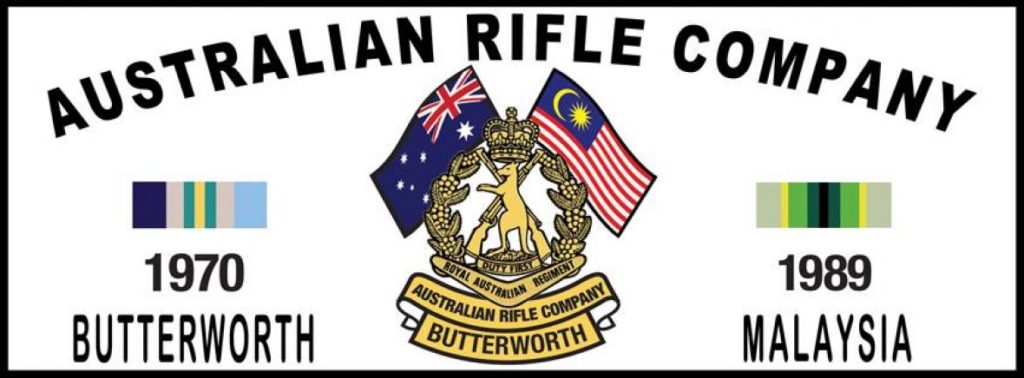There is a long running dispute between the RCBRG and the Defence Department on the rightful categorisation of RCB’s service in Malaysia 1970 – 1989 to protect the RAAF assets at Air Base Butterworth (ABB) during the Communist Insurgency (1969-1989). Defence records this service as peacetime service while the RCB troops seeks to prove it is warlike service.
For over 16 years an RCB review group of veterans (RCBRG) have challenged both the truth of Defence’s decision and the procedural unfairness of its complaints process with evidence from a huge number of documented sources including declassified 211 secret and 18 top secret documents many obtained from Freedom Of Information requests.
In this article I examine the criteria for warlike service to test Defence’s decision not to classify RCB service as warlike. I come to this matter with personal knowledge and experience as:
- Commanding Officer 8/9 RAR in 1975–1976 where in that time the Battalion deployed two companies to Air Base Butterworth (ABB);
- Platoon Commander with 1 RAR 1960 during the Malayan Emergency;
- Company Commander with 9 RAR 1968-1969 in Vietnam;
- Instructor in Tactics at the Jungle Training Centre 1971-1973 specialising in Counter Revolutionary Warfare; and
- A practical researcher and analyst of discovered documents related to the RAAF’s role and presence at ABB, the role, deployment and operations of RCB, and Malaysia’s Communist Insurgency.
In this examination we must start with Defence’s definitions for the nature of service classifications that expresses the extent to which ADF personnel deployed on an ADF operation, or on a third country deployment, in a specified area and within a specified timeframe, are exposed to the risk of harm from hostile forces as a consequence of executing the approved mission and tasks.
A warlike operation is an Australian Government authorised military operation where ADF personnel are exposed to the risk of harm from hostile forces that have been assessed by Defence as having the capability and an identified intent to directly target ADF personnel. ADF personnel are authorised to use force to pursue specific military objectives and there is an expectation of ADF casualties as a result.
A peacetime classification acknowledges that an element of hazard and risk is inherent to ADF service and that personnel are appropriately trained and compensated for their specific military occupation. Service on peacetime operations is not the same as serving overseas on a posting or short-term duty. A peacetime operation is an Australian Government authorised military operation or activity that does not expose ADF personnel to a Defence-assessed threat from hostile forces. Therefore, there is no expectation of casualties as a result of engagement with hostile forces. There may be an increased risk of harm from environmental factors consistent with the expectation that ADF personnel will from time to time perform hazardous duties.
A non-warlike operation is an Australian Government authorised military operation which exposes ADF personnel to the risk of harm from designated forces or groups that have been assessed by Defence as having the capability to employ violence to achieve their objectives, but there is no specific threat or assessed intent to target ADF personnel. The use of force by ADF personnel is limited to self-defence and there is no expectation of ADF casualties as a result of engagement of those designated forces or groups.
Justice Clarke in his 2002 Report to Government Chapter 14 said: “In determining the nature of service for an approved operation, the Department of Defence uses three primary factors: the mission, the rules of engagement and the threat to ADF personnel.”
An examination of these three primary factors reveals the following:
- The Mission. “Warlike operations are those military activities where the application of force is required to pursue specific military objectives, such as a declared war, conventional combat operations against an armed adversary and peace enforcement operations in support of diplomatic efforts to restore peace between belligerents……“
In 2001 the Government accepted this RCB mission in awarding the ASM to RCB and RAAF troops: “In 1970, the Rifle Company Butterworth (RCB) was raised to provide a quick reaction force (QRF) to meet the communist terrorist threat and provide internal security and protection for Australian assets within the perimeter of Royal Malaysian Air Force (RMAF) Base Butterworth.”
The RCB deployment was a conventional combat operation : the defence of the RAAF assets in a Shared Defence Plan with the RMAF within ABB. Specifically, RCB’s primary role, was a QRF to defend against an enemy attack. Inherent in the RCB’s mission was to maintain an Australian presence in Malaysia for sensitive strategic and diplomatic reasons and with its combat sized force to be a deterrent to the enemy’s action.
Defence is a phase of war where a military force deploys to a specific defensive/protective/security mission. Elements of that force deploy into ‘front-line’ positions while others are designated as a reserve force for counter penetration and counter attack roles to stop penetration into the defended area and/or to counter attack to repel, kill and/or capture the enemy. At ABB the RCB QRF was the equivalent: it was NOT a front-line deployment for sentry duties.
- “The Rules of Engagement authorise the application of, and limitations on, the use of lethal force to achieve an assigned mission. In warlike operations, the application of lethal force is authorised, within defined parameters, to achieve the mission. In non-warlike operations, the application of force is limited to self-defence”.
Defence seems to have ignored the fact that the RCB troops were not sentries but a QRF deployed for offensive reaction to an enemy attack. At AAB the Shared Defence Plan had the MAF providing for perimeter defence with sentries and both the MAF and the RAAF providing patrols inside their own dedicated areas within the Base. The QRF would be deployed to action as ordered by the Ground Defence Operations Centre as necessary to stop penetration into the Base area and to counter attack to repel, kill and/or capture the enemy: at that point the QRF’s ROE/OFOF became lethal. This is provable from recorded documents.

- The Threat to ADF Personnel. “The level of threat is implicit in the definitions of warlike and non-warlike service. In warlike operations there is an expectation of casualties, whereas in non-warlike operations casualties could occur but are not expected”.
In 2001 the Government had accepted this threat “The communist terrorist threat was proven to be real with recorded clashes on a number of occasions within its borders until Chin Peng the Communist Leader, signed a peace accord in Dec 89”.

The threat from communist insurgents’ actions were as reported in various intelligence reports from various sources such as: Secret: The Australian JIO Secret Report No 13/75 dated 1 October 1975 – The Security of Air Base Butterworth, and Secret: Butterworth Security Report to the Minister from AVM N.P. McNamara Deputy Chief of Air Staff dated 14 October 1975. There are numerous references to the insurgents regarding who, how many, where, their capacity, tactics, indirect weapons, confirmed attacks and other activities that constituted a warlike threat to ABB. Attacks did occur on other Royal Malaysian Air Force (RMAF) bases in Sungai Besi on 31 Mar 74 and at Kuala Lumpur in 1975.
Pre-deployment, the RCB troops were fully briefed on their combat role, the enemy threat and the expectation of combat casualties. All troops were required to be DP1 status (ready for combat in war) before deployment: the same requirement as for Vietnam service.
A vital principle to be recognised in any consideration of warlike service is The Incurred Danger Test – Justice Mohr Report. He reports:
“In essence, Section 7A of the VEA 1986 requires that a veteran must have ‘incurred danger from hostile forces of an enemy’ before such service becomes ‘qualifying service’ for the ‘service pension’.
On the assumption that we are dealing with rational people in a disciplined armed service (i.e. both the person perceiving danger and those in authority at the time), then if a serviceman is told there is an enemy and that he will be in danger, then that member will not only perceive danger, but to him or her it will be an objective danger on rational and reasonable grounds. If called upon, the member will face that objective danger. The member’s experience of the objective danger at the time will not be removed by ‘hindsight’ showing that no actual enemy operations eventuated”.
RCB’s deterrence was successful with no insurgent attacks. However, during their deployment there were a number of real ‘Amber’ (defence situation imminent) alerts activating the Ground Defence Operations Centre to deploy the RCB’s QRF.
I trust that this article will help your understand the RCB’s claim for warlike service. I believe there is sufficient evidence to have RCB’s service reclassified as warlike.
For more information and support please visit the RCBRG website here
Duty First

Ted Chitham
Lt Col E.A. Chitham MC OAM (retd)
25th March 2022


I agree Ted well said
This is very well written. Although I don’t usually pick up typos, if you are sending this to the government, you may wish to change ‘your’ to ‘you’ in the second last paragraph. Cheers and good luck with this.
Well set out and very logical Ted.
Just a thought, looking at the picture with the diggers wearing lids, why would they have been needed when I was there in 74 with 5/7 giggle hats where sufficient, so did the threat escalate, enough to warrant wearing them.
Excellent work Ted possibly the most accurate, succinct work I have seen on RCB to this point, hopefully this has also gone to Minister Gee
Thank you for your efforts Sir, we are all very grateful
Outstanding research and well presented argument based on civil standard of proof. That being reasonable satisfaction. Ie: To be reasonably satisfied, a delegate must consider that a piece of evidence is more likely than not to be true. The reasonable satisfaction standard of proof is also referred to as the balance of probabilities.
A very well written, to the point summary of the reasons why RCB service should be properly recognised as warlike service. As mentioned there are many documents that uphold the claim that such service at ABB during the Malaysian Second Emergency was indeed warlike. The available evidence is overwhelmingly strong so that any logical thinking person could only come to the conclusion that service at ABB between 1970 and 1989 was in fact warlike. To deny this evidence and the subsequent recognition of those who served is truly unforgiveable and un-Australian.
I can see that members are passionate about this matter and I totally support the group. Best wishes
A question. On arriving at 3sqn one morning (can not recall the date think sometime mid 1975 we were informed that during the night the hangars had been hit with mortar fire that had been ineffective),
Consequently the aircraft were dispersed and not parked close as was the normal practice .
Until such time as it was deemed the thhreat had reduced.
Is there any record of this?
If there was no danger why did we have the word kumpul. When this phone call arrived it meant leave the wife and children at home. Buses would be organised to get them packed and ready to leave country. My job and all other aircraft trades was to get every aircraft serviceable bombed and fueld up and at the bottom.of the airstrip ready to go. Never heard of this on any other overseas posting.
This is an accurate exposition of the situation into which I took A Coy 8RAR( later 8/9 RAR ) in August 1973 .However the situation was not disclosed to me verbally or in my CGS Directive ,prior to my departure with the Company from Australia .There was a vale of secrecy over the whole deployment.This being the case I insisted with the backing of CO 8RAR, that the whole Company undergo a full BE course at JTC,Canungra, prior to deployment.This was immediately agreed to by FF Comd in Sydney .Only on arrival at Butterworth was the situation and real role ( as accurately described by Ted Chitham ) disclosed to me by Air Commodore Peter Raw (AS forces Commander) to whom I had direct access at all times thereafter.At all times I had a fully armed Rifle Section ready to react immediately to any Air Base incursion and the remainder of their Platoon on stand by as a full Ready Reaction Force ….24 hours a day.
I deployed with RCB Feb ‘79.
C Coy 2/4RAR, under OC Maj Ron Chandler, MC
Incidentally, China bombed Hanoi North Vietnam, circa this period!.
I believe the ‘issue’ has drawn out far too long, & I think the vast majority of Veterans need closure in the ‘plus side of the ledger ASAP?!.
Thanks for your overview Ted!.
Excellent work Ted, I am at a loss as to why this period of service at the Air Force Base at Butterworth has not been classified as WAR LIKE. Your team has spent many years .(with proof) trying to convince Canberra. They will wait until there is only a few members alive and then probably approve all of your hard work.
I cannot support this enough. I am one of the RCB commanders, and the photo in Ted’s blog I took. They are my men; we were riled for warlike service and we delivered. I am already on record as stating I personally saw Secret documents and was briefed as such on my mission before we deployed. As the primary researcher and master document database manager for the RCB Review Group I remain willing and capable of supplying information that negates every piece of nonsense that Defence throws up as they mis-inform our Minister. We remain hopeful that he will take the only fair and evidence-based decision he can , NOW, and declare our service as what it was-warlike.
Fully agree with all information presented. Personally, i was a RAAF Ground Defence Officer (cos Portsea qualified INF) and filled the role of 2IC in the Ground Defence Operations Centre 1982/83. The RAAF also had a Base Combatant Flight that my staff trained in basic INF tactics of fire and movement, counter attack to augment RCB or undertake guarding and QRF tasks on ABB or RAAF MQ Areas as part of the Families Protection Plan.
Succinct and to the point Ted, well written and researched.
This is a very comprehensive analysis and evaluation.
Thank you!
I was posted to Butterworth with 2/4 RAR and recall sighting a Maylasian helicopter that had damage from a good spray of light arms fire. It was then I realised our mission was more than just ‘peacekeeping ‘